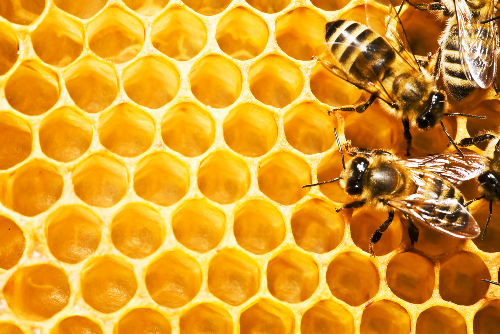Beeswax is a natural wax produced in the bee hive of honey bees. It is mainly esters of fatty acids and various long-chain alcohols. The three major beeswax products are yellow beeswax, white beeswax, and beeswax absolute. Yellow beeswax is the crude product obtained from the honeycomb. White beeswax is made from yellow beeswax by bleaching, and beeswax absolute is made by treating yellow beeswax with alcohol.
- The three main types of beeswax products are yellow, white, and beeswax absolute. Yellow beeswax is the crude product obtained from the honeycomb, white beeswax is bleached yellow beeswax, and beeswax absolute is yellow beeswax treated with alcohol.
Contents
Uses
- Small amounts of beeswax have food and flavoring applications, and are edible in the sense of having similar toxicity to indigestible plant waxes.
- As medicine, beeswax is used for lowering cholesterol and for relieving pain. It is also used for swelling (inflammation), ulcers, diarrhea, and hiccups.(1)
- In foods and beverages, white beeswax and beeswax absolute are used as stiffening agents.
- In manufacturing, yellow and white beeswax are used as thickeners, emulsifiers, and as stiffening agents in cosmetics. Beeswax absolute is used as a fragrance in soaps and perfumes. White beeswax and beeswax absolute are also used to polish pills.
- Beeswax has many and varied uses. Primarily, it is used by the bees in making their honeycomb foundations. Apart from this use by bees, the use of beeswax has become widespread and varied. Purified and bleached beeswax is used in the production of food, cosmetics, and pharmaceuticals.
- In food preparation, it is used as a coating for cheese; by sealing out the air, protection is given against spoilage (mold growth). Beeswax may also be used as a food additive E901, in small quantities acting as a (glazing agent), which serves to prevent water loss, or used to provide surface protection for some fruits. Soft gelatin capsules and tablet coatings may also use E901. Beeswax is also a common ingredient of natural chewing gum.
- Use of beeswax in skin care and cosmetics has been increasing. Beeswax is used in lip balm, lip gloss, hand creams, and moisturizers; and in cosmetics such as eye shadow, blush, and eye liner. Beeswax is an important ingredient in mustache wax and hair pomades, which make hair look sleek and shiny.
- From a relatively small production of about 10,000 tons a year, a number of different niches are served: beeswax is an ingredient in surgical bone wax, which is used during surgery to control bleeding from bone surfaces; shoe polish and furniture polish can both use beeswax as a component, dissolved in turpentine or sometimes blended with linseed oil or tung oil; modeling waxes can also use beeswax as a component; pure beeswax can also be used as an organic surfboard wax.
Benefits
- As medicine, beeswax is used for lowering cholesterol and for relieving pain. It is also used for swelling (inflammation), ulcers, diarrhea, and hiccups.
- Beeswax has mild anti-swelling (anti-inflammatory) effects. There is also some evidence that it might help protect the stomach.
- Acne: The effectiveness of beeswax for acne treatment and control is well known. It has strong antiseptic, healing, and anti-inflammatory properties that are effective in the treatment of acne. Beeswax contains vitamin A, which is an added advantage in the treatment of acne. It is also an excellent skin softener and emollient that helps maintain a smooth skin texture after acne elimination. A combination of non-comedogenic skin care products, diet, and exercise is the best way to control and prevent acne.
- Dry skin: The ability of beeswax to lock in moisture has made it an important ingredient in a variety of lotions and creams for treating dry skin. In addition, its rich vitamin A content and emollient properties help in the healthy development of skin cells. It is a natural moisturizer that not only treats dry skin, but also helps prevent it. You can combine beeswax with Almond Oil and a few drops of vitamin E oil to prepare a homemade remedy for dry skin.
- Eczema: Beeswax is a great treatment for skin problems like eczema that cause an itchy skin rash. Eczema is a common skin problem especially during the colder months that results in extremely dry skin. A mixture of beeswax, olive oil, and honey is effective in relieving the symptoms of eczema as well as psoriasis. The medicinal properties of beeswax help in reducing eczema inflammation and prevent further infection.
- Lip care: The natural moisturizers in beeswax make it a good balm for the lips. You can easily treat problems like cracked or chapped lips with the help of topical beeswax applications. You can make your own lip balm by combining beeswax with vitamin E oil, coconut oil, honey, and essential oils of either orange, peppermint or lemon.
- Stretch marks: Stretch marks are a common complaint especially after pregnancy or because of weight gain or weight loss. You can combine beeswax with wheat germ oil, vitamin E oil, apricot kernel oil, and Cocoa Butter to prepare a natural remedy for preventing and treating stretch marks.(2)
Side Effects
Beeswax is safe for most people.
Special Precautions & Warnings:
Pregnancy and breast-feeding: Not enough is known about the use of beeswax during pregnancy and breast-feeding. Stay on the safe side and avoid use.
Reference
Source(1): WEBMD, web article (user reviewed), www.webmd.com
Source(2):Diet Health Club, web article-“Beeswax Health Benefits”; www.diethealthclub.com/

